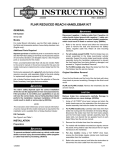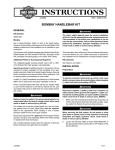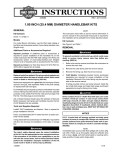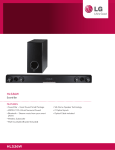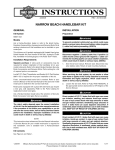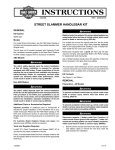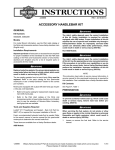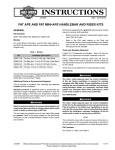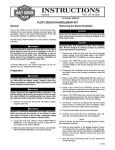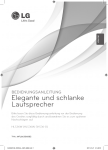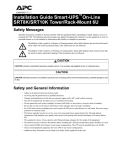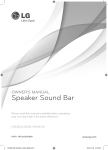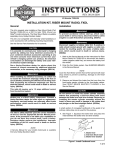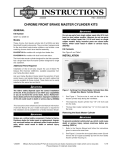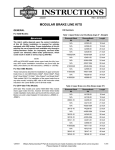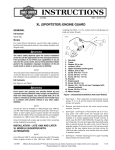Download FLTR Fat Mini-Ape Handlebar Instruction Sheet - Harley
Transcript
-J05389 REV. 2011-04-15 FLTR FAT MINI-APE HANDLEBAR Handlebar Removal GENERAL NOTE Kit Number Cover the front fender and the fuel tank with clean shop towels to prevent scratching. Damage to the finish could result. 55800094 Models For model fitment information, see the P&A Retail Catalog or the Parts and Accessories section of www.harley-davidson.com (English only). 1. See the service manual and remove the front brake master cylinder and clutch lever assemblies from the handlebar and move them out of the way. 2. See the service manual and disconnect the clutch cable from the clutch lever. 3. See the service manual and disconnect the clutch cable from the side cover. Remove the cable from the vehicle. 4. See the MOLEX ELECTRICAL CONNECTORS section of the service manual. Disconnect the handlebar control wiring. 5. Disconnect the handlebar control wiring from the gray sixteen-way and black twelve-way main harness connectors inside the headlamp nacelle. Additional Parts Required Separate purchase and installation of additional parts or accessories may be required for proper installation of this kit on your model motorcycle. See the P&A Retail Catalog or the Parts and Accessories section of www.harley-davidson.com (English only) for a list of required parts or accessories for your model. The rider's safety depends upon the correct installation of this kit. Use the appropriate service manual procedures. If the procedure is not within your capabilities or you do not have the correct tools, have a Harley-Davidson dealer perform the installation. Improper installation of this kit could result in death or serious injury. (00333a) NOTE DO NOT remove the wires from the Molex handlebar switch connector pin housings inside the nacelle. 6. Note the wire colors and positions in each cavity of the socket housings leading from the switches. Refer to the wiring diagram and the MOLEX ELECTRICAL CONNECTORS section in the service manual. Remove the wires (with socket terminals) from the socket housings. 7. See the service manual. Remove the right side switch housing assembly and harness. 8. See the service manual for removal of the left side switch housing assembly and wire harness. 9. If the plastic wiring retainer clips that secured both switch harnesses to the handlebar are still attached to the harnesses or handlebar, remove and discard them. NOTE This instruction sheet references service manual information. A service manual for your model motorcycle is required for this installation and is available from a Harley-Davidson Dealer. Kit Contents See Figure 4 and Table 1. INSTALLATION Preparation 10. If the left side hand grip is not glued to the handlebar: Remove the end cap from the grip, if so equipped. To prevent accidental vehicle start-up, which could cause death or serious injury, remove main fuse before proceeding. (00251b) 1. See the service manual and remove the main fuse. 2. See the service manual and remove the outer fairing and remove the instrument nacelle and bezel. 3. See the service manual and remove the ignition switch and switch plate. Remove the hand grip and set it aside for installation onto the new handlebar. 11. Remove the end cap from the existing right handlebar grip if so equipped. Remove the grip from the handlebar. NOTES The twist grip sensor in the right side of the handlebar has a seal cap that protects internal electrodes from dirt and moisture, and also serves as a retention device for the throttle grip. To remove the grip, a slight tug may be necessary to release the index pins in the grip from the receptacle in the seal cap. -J05389 1 of 6 If the throttle grip IS being replaced: Discard the throttle grip and proceed to Step 11. is00328g 1 If the throttle grip IS NOT being replaced: Upon removing the grip, note if the seal cap is attached to the end of the twist grip sensor. • If the seal cap is attached to the sensor, proceed to Step 11. • If the seal cap is still fastened to the index pins inside the throttle grip, use a stiff piece of mechanics' wire to lasso the seal cap and pull it free of the index pins. 2 6 7 The original equipment (O.E.) twist grip sensor MUST be replaced with a new sensor. If carefully removed, the O.E. sensor can be saved for possible re-use at a later time. Access the six-way twist grip sensor jumper harness connector [204] inside the vehicle, and disconnect the black Molex connector halves. b. Gently pull the twist grip sensor and wires out of the handlebar until the small green connector pair is exposed. c. Note: the external latch on the small green twist grip sensor connector inside the handlebar will break if the twist grip sensor is pulled too hard. A damaged latch will prevent positive engagement of the pin and socket housings. Since the pin and socket housings are not serviceable, any damage will render the O.E. twist grip sensor or jumper harness unusable. Disconnect the green socket housing on the sensor from the green pin housing on the jumper harness inside the handlebar by carefully prying up the latch with a small, flat screwdriver or similar tool. d. Remove the twist grip sensor from the vehicle and set aside for possible future use. e. Pull the jumper harness out through the lower center wire exit slot in the handlebar and set aside for possible future use. 13. See Figure 1. Remove and discard the screws (1) that fasten the handlebar upper clamp (2) to the risers (4). Remove and discard the clamp. Remove the handlebar (3) from the motorcycle. 6 5 1. 2. 3. 4. 5. 6. 7. 8. 9. 9 Clamp screw (4) Upper clamp Handlebar Handlebar riser (2) Riser attaching screw (2) Cup washer (4) Spacer (2) Handlebar bushing (4) Ground strap Figure 1. Handle Clamp and Risers New Handlebar Wiring NOTE Handlebar Kit MUST be installed HANDLEBAR SWITCH WIRING ONLY. 1. with INTERNAL Obtain three pieces of string, mechanics' wire or equivalent, each of sufficient length to extend inside the handlebar, from the end of the bar to the lower center wire slot, plus six to twelve inches (15-30 cm) of additional length to extend beyond the openings. a. Tie a small weight (for example, a spare nut or washer small enough to fit through the center wire slot) to one end of each string. b. Insert the weighted end of two of the strings into the right side handlebar end (with twist grip sensor teeth), and tip the handlebar so that the weights and strings slide down the handlebar to the lower center wire slot. 14. Remove risers (4), riser bolts (5), cup washers (6), spacer sleeves (7), rubber bushings (8) and ground strap (9). Retain riser bolts and cup washers for later installation. -J05389 4 8 12. Refer to TWIST GRIP SENSOR: REMOVAL in the service manual, and follow the instructions for your model motorcycle to remove the O.E. twist grip sensor. a. 3 If necessary, an air hose can be used to blow the weights and strings through the handlebar to the center slot. c. While ensuring that the non-weighted ends of the strings remain extended out of the right side handlebar end, pull the weighted ends out of the lower center wire slot. Remove the weights from the strings. d. With a tweezers or similar tool, fish one string out through the switch wiring slot near the right side handlebar end. 2 of 6 Allow the second string to remain extended out of the right side handlebar end. e. is03096 1 Repeat Steps 1b through 1c with the one remaining string and the left side handlebar end. Fish the string out through the switch wiring slot near the left side handlebar end. 2. If not already done, remove the plastic wiring retainer clips that secured both handlebar switch harnesses to the original handlebar. 3. Use tape to wrap the wire terminal ends from each source to make separate leaders. Wrap each leader tight enough to enter the wire entrance hole at the handlebar switch location, and pass easily through the new handlebar. 4. See Figure 4. Slide a grommet (8) on each switch wire bundle. 3 3 NOTE DO NOT attempt to re-use the O.E. twist grip sensor with the new handlebar. The small green connector on the O.E. sensor is not compatible with internal handlebar switch wiring. The O.E. sensor MUST be replaced with a new sensor (Part Number 32310-08), sold separately. 5. 1. Upper switch housing screw 2. Lower switch housing screw 3. Pinch points Obtain the Twist Grip Sensor Kit (purchased separately). Use tape to wrap the wire terminals on the ends of the Twist Grip Sensor wires to make a single leader. Wrap the leader tight enough to pass easily through the new handlebar. 6. 2 Tie or tape the end of the string from the right side handlebar end hole to the Twist Grip Sensor wire bundle. 7. Tie or tape the end of the string from the right side switch wire hole to the right side switch wire bundle. 8. Apply a light coat of liquid soap, window cleaner, or allpurpose lubricant such as WD-40®, to the right side switch and Twist Grip Sensor wire bundles. Wiring in the switch housings must be routed exactly as shown. Pinch points in the switch housings can shortcircuit or sever wires, which could cause loss of control resulting in death or serious injury. (00415b) Figure 2. Switch-Housing Wire Routing (Right-Side Housing Shown) 9. Gently feed the Twist Grip Sensor wire bundle into the right side handlebar end. See Figure 2. Route the right side switch wire bundle through the switch housing as shown. Gently feed the wire bundle into the right side switch wire hole. Pull the bundles down through the new handlebar and toward the center of the bar, while fitting the index tabs on the twist grip sensor into the slots on the end of the handlebar. One index tab and slot are smaller than the other to prevent improper assembly. Carefully pull the wires through hole in handlebar to prevent stripping the wires. Stripped wires can cause short circuits and damage vehicle electrical components, which could cause loss of vehicle control resulting in death or serious injury. (00418b) 10. Pull the taped ends of the wire bundles through the wireexit hole at the bottom center of the handlebar. Grommets in each of the wiring holes in the handlebar must remain in position after routing the wiring through the handlebar. Operation without the grommets in place can damage wires, causing a short circuit which could result in death or serious injury. (00416d) 11. Tie the end of the string from the left side switch wire hole to the left side switch wire bundle. 12. If necessary, apply a light coat of liquid soap, window cleaner, or all-purpose lubricant such as WD-40®, to the left side switch wire bundle. -J05389 3 of 6 13. Route the left side switch wire bundle through the switch housing similar to that shown in Figure 2 for the right side wiring. Gently feed the wire bundle into the left side switch wire hole. Pull the bundle down through the new handlebar and toward the center of the bar. 14. Insert the switch wire grommets into place in the switch wire holes in the handlebar. 15. Loosely fasten the brake lever and clutch lever clamps to the new handlebar. 16. Loosely fasten the handlebar switch housings to the new handlebar. 17. Remove the tape from the ends of the wire bundles. 18. Check for electrical continuity between the handlebar and each wire in the wire bundles. Continuity would indicate a short circuit, which would require examination of the wires and routing in the switch housing. New Handlebar Installation 1. See Figure 3. Position each riser (6) with the mounting hole to the outside as shown. 9. Obtain the six-way black Molex pin housing from the Twist Grip Sensor Kit. Insert each pin terminal from the twist grip sensor into the correct cavity of the pin housing as follows: From the yellow conduit, a. BLACK wire to cavity 1 b. WHITE wire to cavity 2 c. RED wire to cavity 3 From the black conduit, a. BLACK wire to cavity 4 b. WHITE wire to cavity 5 c. RED wire to cavity 6 10. Connect the six-way black Molex pin housing from the twist grip sensor to the black six-way socket housing inside the nacelle. Position the previously installed PVC tubing to prevent chafing of the twist grip sensor wires at the center handlebar wire hole, inside the nacelle. 4 Install the new risers (6) and new rigid bushings (9) onto the upper fork bracket with the saved hardware as shown. Snug the riser bolts, but do not fully tighten at this time. 2. Center the new handlebar (7) on the risers. 3. Position the new handlebar upper clamps (included in the Handlebar Riser Kit) with the rounded "lobes" (8) inboard, as shown, and loosely install with new clamp screws and flat washers from the kit. NOTE The handlebar upper clamps are machined to leave a gap between the clamp and riser on one side of the handlebar when installed. The non-gap side will be to the front of the handlebar on the left clamp and to the rear on the right clamp when the lobes are oriented inward. 4. Snug only the front screw (1) on the left side clamp. b. Snug only the rear screw (2) on the right side clamp. NOTE See the service manual for disconnection and connection procedures. 5. Insert each socket terminal from the right side switch harness into the correct cavity of the black socket housing removed earlier. 6. Insert each socket terminal from the left side switch harness into the correct cavity of the gray socket housing removed earlier. 7. Connect the gray socket housing to the gray eight-way pin housing inside the nacelle. Connect the black socket housing to the black six-way pin housing inside the nacelle. If equipped, connect the three-way cruise control pin and socket housings in the same manner. 8. is04718b 3 8 12 1 8 7 10 9 5 6 Snug the upper clamp screws, but do not fully tighten, in the following sequence: a. 2 1. 2. 3. 4. 5. 6. 7. 8. 9. 10. 11. 12. 10 6 11 Tighten left front screw Tighten right rear screw Tighten left rear screw Tighten right front screw Front of vehicle Riser mounting holes to outside Handlebar Upper clamp with lobes to inside (2) Rigid bushing from kit (4) Cup washers, previously removed (4) Riser bolt, previously removed (2) Ground strap (left side only) Figure 3. Handlebar and Clamp Assembly to Risers 11. Slowly turn the front wheel to the full-right fork stop and then the full-left fork stop to be sure the handlebar does not contact the fairing. If contact occurs and the handlebars are properly centered, raise or lower the handlebar angle as necessary until proper clearance is attained. Obtain the PVC tubing from the Twist Grip Sensor Kit. Install the tubing over ALL of the wires coming from the twist grip sensor. -J05389 4 of 6 NOTES The upper handlebar clamp screws MUST be final-tightened in the following sequence so that proper clamping is achieved. FINAL ASSEMBLY 1. Position the PVC tubing on the twist grip sensor wires (installed in New Handlebar Installation, Step 7) to prevent chafing of the twist grip sensor wires against the sharp edges inside the fairing, such as the heat sink fins on the radio (if so equipped) or the sharp edges of the radio or storage box mounting bracket. 2. Refer to INSTRUMENT NACELLE: FLTR: INSTALLATION in the service manual, and follow the instructions to install the instrument nacelle and bezel. There will be a slight gap between the upper clamps and the risers toward the left rear and right front of the handlebar after tightening. 12. See Figure 3. Tighten the upper handlebar clamp screws as follows: a. Tighten the left front screw (1) to 12-16 ft-lbs (16.321.7 Nm). b. Tighten the right rear screw (2) to 12-16 ft-lbs (16.321.7 Nm). c. Tighten the left rear screw (3) to 12-16 ft-lbs (16.321.7 Nm). d. Tighten the right front screw (4) to 12-16 ft-lbs (16.321.7 Nm). 13. One at a time, remove the riser bolts. Apply a small amount of Loctite® 271 (Red) to the bolt threads and install. Tighten the riser bolts to 30-40 ft-lbs (41-54 Nm). See UPPER FAIRING AND WINDSHIELD: FLTR: OUTER FAIRING: INSTALLATION in the service manual, and install the outer fairing. Replace brake line gaskets. Re-using original gaskets can cause brake failure and loss of vehicle control, which could result in death or serious injury. (00318a) 14. Install a new (purchased separately) or original hand grip on the left end of the new handlebar according to the hand grip instruction sheet or an appropriate service manual. Avoid leakage. Be sure gaskets, banjo bolt(s), brake line and caliper bore are clean and undamaged before assembly. (00321a) 15. Adjust the positions of the switch housing and the clutch lever assembly on the handlebar for rider comfort. 3. 16. Tighten the top then the bottom clutch lever clamp screws to 72-108 in-lbs (8.1-12.2 Nm). 17. Tighten the lower then the upper switch housing screws to 35-45 in-lbs (4.0-5.1 Nm). NOTE If the hand grips are patterned, align the pattern on the right hand grip with the pattern on the left hand grip while the throttle is in the fully-closed position. 18. Refer the appropriate service manual, and follow the instructions given to install the new (purchased separately) or original right hand grip/throttle sleeve. 19. Adjust the position of the switch housing and the brake lever assembly on the handlebar for rider comfort. The brake master cylinder must be as close to level as possible when the vehicle is on the sidestand and the handlebar is turned to the left steering stop. NOTE Tighten the top brake lever clamp screw before tightening the bottom screw. 20. Tighten the top then the bottom brake lever clamp screws to 72-108 in-lbs (8.1-12.2 Nm). NOTE Tighten the lower switch housing screw before tightening the upper screw. This will leave any gap in the switch housing at the front for best appearance. 21. Tighten the lower then the upper switch housing screws to 35-45 in-lbs (4.0-5.1 Nm). If replacing OE brakelines, carefully inspect the new (sold separately) or existing front brake line or lines for damage or defects, and replace if damaged. Install per FRONT BRAKE MASTER CYLINDER: FRONT BRAKE LINE, INSTALLATION in the service manual or the instructions included with the brake lines. If NOT replacing OE brakelines, go to step 5. 4. Bleed the brakes. See BLEEDING HYDRAULIC BRAKES in the service manual. 5. Install a new clutch cable (sold separately) per the CLUTCH CABLE: INSTALLATION instructions in the service manual. SAFETY CHECK Be sure that steering is smooth and free without interference. Interference with steering could result in loss of vehicle control and death or serious injury. (00371a) • Be sure cables are not pinched between the frame and/or forks. • Be sure clutch cables do not pull tight when handlebars are turned fully to left or right fork stops. • Be sure throttle/idle control cables do not pull tight when handlebars are turned fully to left or right fork stops. 1. Verify that the Ignition/Light Key Switch is turned to the OFF position. 2. Install main fuse. 22. Verify that the right hand grip/throttle sleeve rotates and returns freely and does not bind on the handlebar or switch housing. -J05389 5 of 6 Be sure that all lights and switches operate properly before operating motorcycle. Low visibility of rider can result in death or serious injury. (00316a) 3. Turn the Ignition/Light Key Switch to IGNITION, but do not start the motorcycle. Test each handlebar switch for proper operation. 4. Turn the handlebar to the left and right steering stops, testing the handlebar control functions at each stop. 5. Apply the front brake hand lever to test operation of the brake lamp. Before starting engine, be sure throttle control will snap back to idle position when released. A throttle control that prevents engine from automatically returning to idle can lead to loss of control, which could result in death or serious injury. (00390a) After repairing the brake system, test brakes at low speed. If brakes are not operating properly, testing at high speeds can cause loss of control, which could result in death or serious injury. (00289a) SERVICE PARTS is07009 2 3 4 5 6 1 8 7 Figure 4. Service Parts: FLTR Fat Mini-Ape Handlebar Table 1. Service Parts Table Item Description (Quantity) Part Number 1 Handlebar, 1-1/4 in, 12 inch mini-ape, chrome Not Sold Separately 2 Riser kit, fat handlebar (includes items 3 through 6) 56789-05 3 • Screw, socket head (4) 4816A 4 • Washer (4) 6046 5 • Clamp, 1-1/4 inch handlebar (2) 55962-02 6 • Riser, 1-1/4 inch handlebar (2) 56380-02 7 Bushing (4) Not Sold Separately 8 Grommet 11386 -J05389 6 of 6






